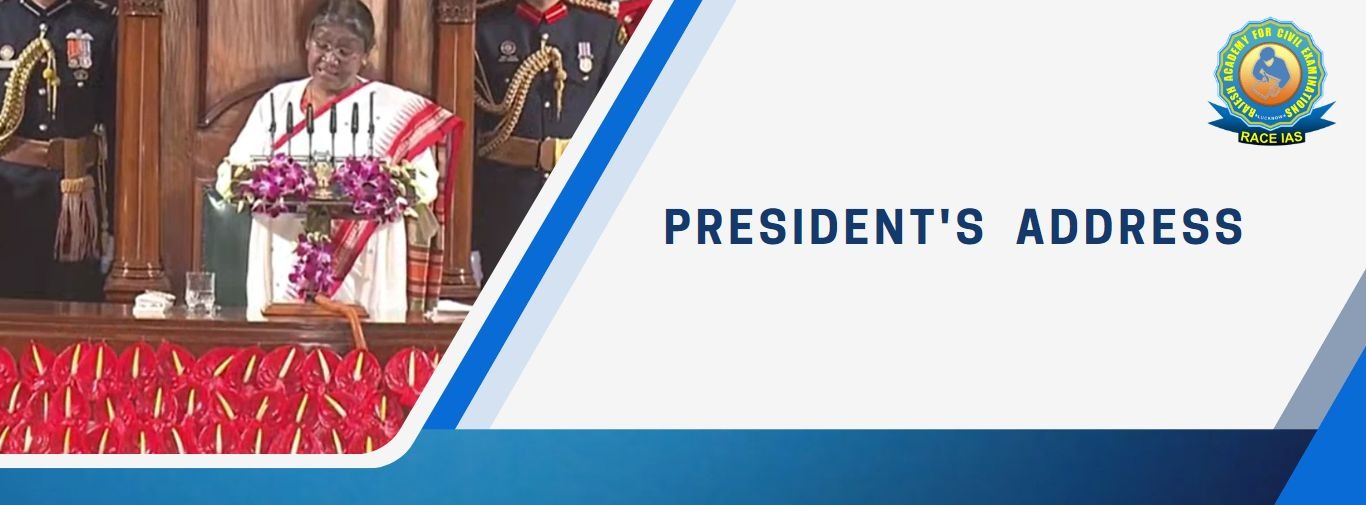
PRESIDENT'S ADDRESS
Current Affairs I PRESIDENT'S ADDRESS I RACE IAS : Best IAS coaching in lucknow
PRESIDENT'S ADDRESS
Main Examination General Studies-2: Indian Polity and Administration
PRESIDENT'S Address, Joint Session, Motion of Thanks, Parliament Session
Why in News:
- President Draupadi Murmu addressed the joint sitting of both the Houses in the Central Hall for the first time.
President's Address:
- The President's address includes details of the government's achievements,policies and future plans for the coming year.
- Every year the first session of the Parliament i.e. the budget session begins with the President's address.
- Apart from this, the President addresses the first session of Parliament after every general election to the Lok Sabha.
- The Parliament is made up of the President, the Rajya Sabha and the Lok Sabha.
- The President is not a member of either house, yet the President's address is a special part of our parliamentary procedure.
- The President's address in the Constitution is mentioned in Article 87 of the Constitution.
- The first session in any year is called the budget session. Therefore, at the beginning of the budget session, the President addresses the joint sitting of both the Houses of Parliament.
- The speech also gives a glimpse of the policies to be adopted by the government in relation to important internal and current international problems.
- The address also mentions the legislative works that is proposed to be brought to Parliament in the sessions to be held during that year.
Constitutional Provisions:
- The President's address is a constitutional requirement, as the session cannot begin without his address. Both the Houses of the Parliament have three sessions in a year. First - Budget Session, Second - Monsoon Session and Third - Winter Session.
- The provision of the President's address in front of either House of the Parliament or both the Houses together has been made in the Constitution. Its provision was made in the Government of India Act, 1919 and it has been running since 1921. The government prepares the speech that the President gives.
- In Article 86 (1) of the Constitution, the President has the right to give an address to either House or both the Houses of the Parliament whenever he wants and to call the members for it. However, till date this article has not been used.
- Article 87 (1) of the Constitution provides that it is mandatory for the President to address both the Houses of Parliament in the first session after the general election and in the first session of every year.
Motion of thanks:
- Members of both the Houses of Parliament do not have the right to question the President's address. But, during the discussion on the Motion of Thanks, members can debate.
- Motion of thanks is a very important part of parliamentary procedure. After the President's address, a motion of thanks is presented in both the Houses of Parliament,the Rajya Sabha and the Lok Sabha, on a fixed date. After this it is discussed in both the houses and after discussion the motion of thanks is approved by both the houses. During this time, members cannot raise such matters, which are not directly related to the government.
- Along with this, members cannot even take the name of the President during the debate,because the proposal for the address is prepared by the government.
Background of the Address:
- The tradition of addressing the House is 400 years old.
- The tradition of addressing the House is not Indian, but of the British. Addressing the House in India began with the Government of India Act of 1919.
- Rajya Sabha was formed in India in 1919, at that time Rajya Sabha was called Council of State. However, the history of Lok Sabha begins from 1853. Initially, the Lok Sabha was called the Legislative Council, which had 12 members.
- After independence on August 15, 1947, the Constituent Assembly was formed, whose president was Dr. Rajendra Prasad. The Constitution was passed in the Constituent Assembly on 26 November 1949 and came into force on 26 January 1950. Some essential provisions from the constitutions of 10 countries have been incorporated in our constitution. The parliamentary system of government has been taken from Britain.
- The provision of the President's address has been made in the Constitution by India and not by Britain.
Conclusion:
- After the Lok Sabha elections, the President's address takes place only after the oath of each MP and after the election of the Speaker of the Lok Sabha. No other work can be done until the President addresses both the Houses.
--------------------------------------------------------------
Main Exam Questions:
Explain the difference between the President's Address and Motion of Thanks.